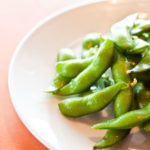Tomatillo and Asian Pear Month is celebrated every year in April and shines some much-deserved light on these underappreciated heroes of the fruit world. We all know oranges, kiwis, strawberries, and mangoes. They are great, but what about the others? How long will we let this tyranny of the popular fruits continue? The apples and bananas of the world have had their fair share of time in the limelight, now it’s time for lesser-known fruits like tomatillos and Asian pears to take over the world! Not only are these fruits delicious, but they’re also extremely healthy. What are you waiting for? Go tomatillo and Asian pear shopping now!
History of Tomatillo and Asian Pear Month
First things first: what exactly is a tomatillo? The fruit is also called Mexican ground cherry or Mexican husk tomato and is native to Mexico and Central America. It is a green tomato-like fruit covered in a papery husk and has a tart, bright, and almost citrusy taste.
Tomatillo is considered to have been first domesticated by the Aztecs in central Mexico around 2,800 years ago and was an important food crop to many pre-Columbian people in Mesoamerica, including the Mayans. During the Spanish conquests of Mexico and Central America in the 16th and 17th centuries, the plant was taken back to Spain. It proved to be less popular than the related tomato and did not sustain in the region. Today, most commercial production comes from Mexico and Guatemala, though the plant is also grown in certain parts of the United States, Australia, and South Africa.
The Asian pears, on the other hand, are thought to have originated in China and Japan. They have grown in these nations and some other Asian countries for at least 3000 years. Some records indicate that Chinese immigrants introduced Asian pears to the west coast of the United States during the 1800s. No wonder then, that the largest concentration of present commercial production of these fruits is in California and Oregon.
The fruit has a crisp and juicy texture along with an apple-like flavor, leading many people to refer to this fruit as the apple-pear, even though the Asian pear has nothing to do with apples.
Tomatillo and Asian Pear Month timeline
The fruit is cultivated in China, Japan, and some other Asian countries.
Tomatillo is first grown by the Aztecs in Central Mexico where it is an important food crop for the pre-Columbian people.
The fruit is taken to Spain during the Spanish conquests of Central America and Mexico but does not gain much popularity.
Asian pears first arrive in North America in Queens and quickly become valuable for their ability to resist fire blight disease.
Tomatillos are introduced to India, where the fruit is quickly incorporated into traditional dishes and is now locally cultivated.
Tomatillo and Asian Pear Month FAQs
Are tomatillos and tomatoes the same?
Tomatillos are a member of the nightshade family, along with tomatoes, potatoes, and peppers. However, green tomatoes are hard, unripe tomatoes that can come from any type of tomato. Tomatillos are not tomatoes, but the fruit of a different plant, which are also covered with papery husks.
How are Asian pears different from pears?
Asian pears are vastly different from the old, hard, European varieties like Keiffer and Seckel. Asian pears have a distinct flavor yet taste pear-like, as well as a crisp texture, much like a nice apple.
Does Asian pear tenderize meat?
Asian pears are a common ingredient in Korean barbecue marinades as they contain enzymes that can tenderize meat. The powerful fruit enzyme called calpain snips the meat’s protein strands into smaller pieces that yield a mushy effect.
Tomatillo and Asian Pear Month Activities
Eat some tomatillos and Asian pears
Go to a market where these fruits might be available or order them online so you can taste the divinity for yourself. You’re in for a real treat if you’ve never tried them. These fruits are yummy on their own and can be eaten raw as well. But remember to eat only ripe tomatillos and clean out the husk properly as they can be poisonous.
Cook with these fresh fruits
Look up some recipes (you’ll find many!) that incorporate tomatillos and Asian pears and get cooking! Tomatillos gain a warmer, sweeter, and earthier flavor when cooked, while Asian pears can be roasted, baked, or steamed and are often used in desserts.
Treat your friends
Call your friends over and cook up a storm with these fruits! You can serve tomatillos as salsa verde, soup, or as a side dish, all of which will only take a few minutes. For dessert, serve some Asian pear crisp, steamed Asian pears with dates and honey, or Asian pear cake.
5 Facts About Tomatillos And Asian Pears That Will Blow Your Mind
They can be pretty to look at
A tomatillo’s husk must be removed before preparing, but tomatillos in the husk are often used as decoration.
They’re used in Chinese medicine
Traditional Chinese medicine considers the Asian pear to be a cure for coughs and bronchial ailments.
They might help with hangovers
Some people believe that eating an Asian pear or having its juice before a night of drinking will counteract a hangover the next day.
Some parts of tomatillos are poisonous
Unripe tomatillos and the husk and calyx of the fruit are toxic and should not be eaten.
Tomatillo means little tomato
The name tomatillo, which means ‘little tomato’ in Spanish, originates from the Nahuatl word ‘tomatl.’
Why We Love Tomatillo and Asian Pear Month
They’re healthy
Tomatillos are rich in fiber, low in calories, and contain the all-important Vitamin C, Vitamin K, and niacin. They also have zeaxanthin and lutein, both of which are necessary for healthy eyes. The Asian pear is a great source of dietary fiber, especially if you eat the skin. It’s also a good source of potassium, Vitamin K, copper, and Vitamin C.
They have many uses
Although tomatillos are primarily used to make salsa verde, they can also be used in stews, sauces, soups, salads, curries, stir-fries, baking, meats, marmalade, and desserts. An Asian pear can be eaten as a raw snack, with salads and a cheese plate, in smoothies or juices, or baked into tarts and pies. They can even be eaten as chips!
It’s a day to try new fruits
Aren’t you tired of eating the same old fruits every day? We know we are! While the classics are great, it doesn’t hurt to try out some new fruits now and then. Eat a tomatillo and an Asian pear today and who knows, you might be enjoying a durian tomorrow!
Tomatillo and Asian Pear Month dates
| Year | Date | Day |
|---|---|---|
| 2026 | April 1 | Wednesday |
| 2027 | April 1 | Thursday |
| 2028 | April 1 | Saturday |
| 2029 | April 1 | Sunday |
| 2030 | April 1 | Monday |



















































































































































